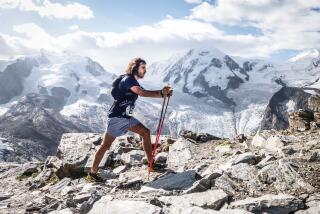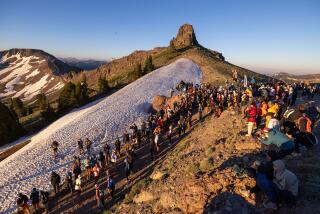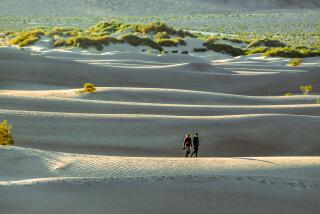Runners Beat Path to Pioneer’s Door
LONE PINE, Calif. — Today’s athletes in the Badwater Ultramarathon are pampered, in a perverse sense. While they run and walk 135 miles across Death Valley, they are tailed by 24-hour-a-day crews in air-conditioned vans. The support teams make them chicken soup on the side of the road and hold up cups so they can sip energy drinks and Pedialytle, to combat diarrhea, vomiting and dehydration.
Sissies.
In August 1977, Al Arnold did it alone.
Trying to become the first person to run from Badwater in Death Valley to Mt. Whitney, he was supposed to be trailed by a crew member, photographer Erik Rakonen.
But the two became separated on the course, so Arnold reversed field and ran back 22 miles, finding his support man asleep in his car.
That didn’t deter Al Arnold. He refused to hitch a ride back to the point where he had turned back. He simply started running again. About 84 hours and 192 miles later--wearing running shoes and briefs--he made it. And the madness that would become known as “The Badwater” was born.
His feat caused a flurry of excitement in the running community, but it was soon forgotten. Arnold wasn’t even aware for many years that his run had morphed into an annual race. Then, two years ago, Badwater director Chris Kostman was researching the race and came across Arnold’s run. Kostman arranged for Arnold to attend his first “official” Badwater this year, on the 25th anniversary.
Now 74, gray-haired and paunchy, with a bum knee he blew out while stooping to pick trash off the floor, Arnold welcomed a steady stream of athletes during this week’s race. Most wanted him to start his tale from the top. And each time, he did.
In 1973, he heard about two men who completed a 150-mile relay from below-sea-level Badwater to Mt. Whitney’s 14,496-foot peak. Arnold wanted to do it too--without a relay partner. After two failed tries, he bounded off from Badwater on a 124-degree day.
Three days later, he approached Lone Pine, a town of about 3,000 that is the gateway to the highest peak in the lower 48 states. When he reached the top, he wept uncontrollably. He had lost 17 pounds, or 8% of his body weight. But his journey wasn’t over.
He stumbled down to a campsite where friends had left warm clothes and a tent to stay the night. But his gear had been stolen, he said, and he spent the night in near-freezing temperatures.
Two weeks later, he was on his honeymoon. While he was bodysurfing, a wave bulldozed him into the sand, leaving him temporarily paralyzed below the neck.
Again refusing to quit, he recovered quickly and ran a marathon four months later. He stopped running two years ago, he said Wednesday in Lone Pine, completing his tale just as the first of the Badwater runners passed through town on the final leg of the race.
Over the years, several racers have tracked him down. Arnold said his favorite letter came two years ago from Jack Denness, a runner from England who is competing this week in the race. The letter tried to sum up the obsession that ultramarathons have become. “When I meet you,” it ended, “I don’t know whether to shake your hand or wring your neck.”
Explained Arnold: “Why is it that the moth is attracted to the flame, when he knows if he gets too close it will burn him? ... It’s dangerous. But it’s the search, the quest.”
Even the other pioneers revere the man who started it all.
Gary Morris caught the Badwater bug after seeing two films near his home in Marina del Rey. One was on marathon racing. The other was on Arnold’s run.
Morris completed the run in 1983, becoming the second person to repeat Arnold’s achievement.
“I thought: Who the hell is Al Arnold?” said Morris, 63 and a member of a Badwater racer’s crew. “Then I saw [the film.] It was like when you were a kid and you dreamed about being dropped from an airplane into the wilderness with a knife in your teeth and just one match. I thought, ‘I have to do this’. And it changed my life.”
More to Read
Go beyond the scoreboard
Get the latest on L.A.'s teams in the daily Sports Report newsletter.
You may occasionally receive promotional content from the Los Angeles Times.











